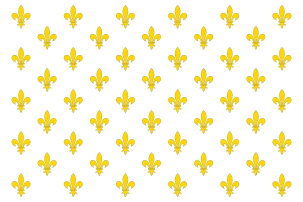Dukes in France

.svg.png)
The title of Duke was the highest title in the French nobility during the time of the monarchy in France.[1]
Old dukedoms
The highest precedence in the realm, attached to a feudal territory, was given to the twelve original pairies, which had originated in the Middle Ages and also had a traditional function in the royal coronation, comparable to the German imperial archoffices.
Half of them were Dukes and half of them Counts. Of these, three were ecclesiastical and three were secular. Of these twelve, the prelates all ranked above the secular peers of the realm and three temporal, and the dukes all ranked above the counts.
Ecclesiastical Dukes
The Prince-Bishops with ducal territories included:
- The Archbishop of Reims, styled archevêque-duc pair de France (in Champagne; who crown and anoint the king, traditionally in his cathedral)
- Two suffragan bishops, styled evêque-duc pair de France :
- the bishop-duc de Laon (in Picardy; bears the 'Sainte Ampoule' containing the sacred ointment)
- the bishop-duc de Langres (in Burgundy; bears the scepter)
Later, the Archbishop of Paris was given the title of duc de Saint-Cloud with the dignity of peerage, but it was debated if he was an ecclesiastical peer or merely a bishop holding a lay peerage.
Secular dukes
Under the House of Capet there were five laic duchies:
- Duke of Normandy, peer of France: mightiest vassal of the French crown, later also kings of England. By privilege, they cannot be summoned by the King of France beyond the borders of the duchy of Normandy; King John of England had attempted to invoke this privilege to avoid the summons of Philip Augustus to his court in Paris. Merged into the French crown, circa 1204.
- Duke of Aquitaine, peer of France: largest landholder of southwestern France, also rulers of Gascony and Poitou. Merged into the French crown, circa 1204. Reconstituted as the duchy of Guyenne in 1259 for the King of England by Saint Louis.
- Duke of Burgundy, peer of France: held by a cadet line of the Kings of France. At some point the duke of Burgundy gained precedence over those of Normandy (then merged with the Crown) and Aquitaine (held by a disobedient vassal) in the French coronation ceremony.
- Duke of Brittany: a vassal of the Duke of Normandy. Promoted to the peerage of France in 1297 by Philip the Fair.
- Duke of Bourbon: originally a lordship, raised to the status of a duchy-peerage by Charles IV in 1327.
Early Modern period
At the end of the 13th century, the King elevated some counties into duchies, a practice that increased through the early modern period until the French Revolution. Many of this duchies were also peerages, so-called new peerages.
Ducal titles traditionally held by princes of the royal blood:
- Duke of Orléans
- Duke of Anjou
- Duke of Berry
- Duke of Angoulême
- Duke of Alençon
- Duke of Touraine
Other notable ducal titles:
- Duke of Guise
- Duke of Lorraine
- Duke of Montpensier
- Duke of Savoy (although Haute Savoie is now part of France, the Dukes of Savoy were Princes of the Holy Roman Empire, not peers of France)
The title of Duke of France refers to the rulers of the Île de France, informally Francia. The dynasts of Robert the Strong's family are usually termed "Dukes of France" and their title evolved into the name for the French nation after one of their members, Hugh Capet, ascended the throne. Since the end of the monarchy, it has been used by pretenders to the French throne such as Prince Henri, Count of Paris.
New dukedoms
After the French Revolution, further dukedoms were created by successive French rulers. Napoleon I created a substantial number of dukes in the Nobility of the First French Empire, largely for Marshals of the Empire and certain ministers, and many of them carried victory titles. The practice of creating dukedoms was continued by the House of Bourbon after the Restoration, and later by Napoleon III.
See also
References
- ↑ E. Armstrong (1 September 2004). The French Wars of Religion Their Political Aspects. Kessinger Publishing. pp. 7–. ISBN 978-1-4179-4847-5. Retrieved 2 August 2013.
The former belonged to the highest rank of non-royal French nobility, and its head, the Duke, possessed the highest ...